4 Most Brilliant Innovators Of Our Time And How They Change The World We Live In
The world we live in is rapidly changing due to innovation. Brilliant individuals are transforming new ideas every day into products and/or services that are valuable to society. It’s always been about offering something more – whether it may be better, cheaper, faster, stronger, etc. As more cutting edge technology is introduced to the population, we will continue to see this rise in innovation.
Let’s take a look at the most brilliant innovators of the past two decades. We have Steve Jobs who got all of us using touch screen phones with functions extended beyond calling and texting. There’s Elon Musk who is spearheading the change from gasoline to electric cars. Jeff Bezos has changed the way we shop. And last but not least, Mark Zuckerberg has gathered one-third of the population on one social networking platform.
They all have one thing in common – relentless innovation. These four geniuses consistently roll out new products and have seen their empires grow over recent years. Although they share the same innovation beliefs, they are four unique individuals working in different industries. And they have their own business and marketing strategies.
Steve Jobs
An extraordinary innovator, Steve Jobs has had 241 patents registered to his name or as a co-inventor. Many of the products he invented went on to be hits in the tech world, notably the iPhone. Before passing away in 2011 from pancreatic cancer, the American entrepreneur was the co-founder, CEO, and chairman of Apple Computer.
Born in 1955 to a Syrian father and American mother, Jobs was given up for adoption to Paul and Clara Jobs. Neither of them were university graduates, but they promised to put him through college. During his early years, he struggled in traditional classrooms and faced some challenges in school. The future genius was a loner and often bullied by classmates, but it did not hinder his progress.
When he was 10, Jobs took a keen interest in electronics. He became friends with all the engineers in the neighborhood. At the age of 13, he got a summer job with Hewlett-Packard after cold-calling them for some electronic parts. Then during his high school years, he met his future business partner Steve Wozniak.
By his senior year in late 1971, Jobs became fascinated with electronics and completed his first project with Steve Wozniak – the low-cost digital blue box. The sales were excellent and this gave them the idea that they could do wonders. He later attended Reed College but dropped out after only one semester citing that education was not for him.

After some stints with Atari and a spiritual trip in India came the birth of Apple. In 1976, Wozniak and Jobs joined forces once again with operations beginning in the latter’s bedroom. There was a third co-founder by the name of Ronald Wayne, but he didn’t stay in the picture for very long.
The duo decided on the name “Apple” after Jobs returned from a farm in Oregon. He had spent time on a farm’s apple orchard. To raise funds for their project, they had to sell some of their personal belongings. Wozniak sold his HP scientific calculator and Jobs sold his Volkswagen van. Sacrifices had to be made so they could build the first batch of the circuit boards for Apple I.
About 21 years later and a plethora of tech products, Steve Jobs unveiled a game-changer in 2007 – the iPhone.
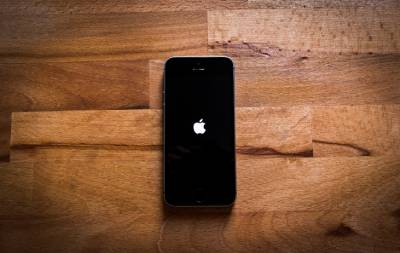
On June 29, 2007, Apple’s launched its first iPhone. Although it wasn’t the first smartphone, it managed to outperform its competition so heavily that a mobile revolution ensued. It changed the game.
“This is a day I’ve been looking forward to for two and a half years,” said Steve Jobs on the day of the launch.
After 11 years in the market, Apple had recorded 2.2 billion units sold. It is a series of smartphones that is capable of doing many things a computer can do, but small enough to be carried around in your hand. The whole idea for this phone came into being when Jobs was trying to combine the features of an iPod with that of a phone and computer.
The awesome combination of design, power, multimedia features, and the AppStore catapulted the iPhone to success. Because of its multifunctionality, it became very popular with consumers.
Here are some major influences of the iPhone and how it has changed our daily lives.
Touch Screen
Entering a Blackberry-dominated era, who would have thought that this touch-screen device would take off like a rocket. Jobs made a very daring move that took the world by a storm. His innovation made traditional keyboard smartphones obsolete. Other smartphone companies followed the trend and these days, you’ll find touchscreens on every phone and tablet.
A touchscreen is a computer screen that responds to touch. The touchscreen makes it so much more convenient to browse, use apps, play games, and so much more. By not having a physical keyboard, it doesn’t waste any space, giving you a huge area for the screen.
One Device for Everything
Before the iPhone landed in the market, people had to go through the hassle of carrying multiple devices. It was typical to see a person with a cellphone for making calls, iPod or MP3 player for music, and a laptop for work. But today, you can do these three things with just the iPhone.
Not to mention, the camera feature. Back then, people would bring their digital cameras around. But with the iPhone and its decent camera quality, you no longer need a camera. The coverage of its features is so broad, you literally need just one device for everything.
Internet Browsing
This is yet another feature that already existed, but the iPhone made obvious improvements that changed the experiences of its users and the way we do things. Back then, you might recall being able to browse the Internet on earlier smartphones. However, the experience was never the same as using a laptop.
This Apple device paved the way to better browsing and instant information. If we quickly need to search something, we no longer have to wait to get on a laptop. We just need to reach in our pockets and open Google on our phones.
Video Recording
Speaking of obsolescence, the iPhone pretty much had the same effect on the handheld camcorder. When cameras were first installed on phones, it was already a big deal. And then the iPhone took it a step further when it came with a built-in video recorder. The quality is so good that some people don’t even use their camcorders anymore.

The fact that we’re able to so easily record moments has also led to the wide use of videos. Social media platforms such as Instagram and TikTok have been on the rise with more and more demands for video content around the world. It is a common past time to post videos and stories.
Selfies
It is pure speculation that the term “selfie” was coined by some Aussie guy. It is the slang word for a self-portrait digital photograph taken with a digital camera or smartphone. Although selfies have long existed, the term and practice only grew in popularity in 2010 when Apple launched the iPhone. It was yet another breakthrough in the sphere of innovation.
The iPhone 4 featured a front-facing camera, which made it easier for people to take selfies. With the camera facing the front, you could see the angle at which you were taking the photo. Today, all phones feature this type of camera. Love them or hate them, selfies are here to stay.
Apps
Not only a game-changer, but the iPhone also gave birth to a completely new industry – apps. With the Apple AppStore, it digitally distributed applications that users could install on their phones. Today, you can find apps for almost everything.
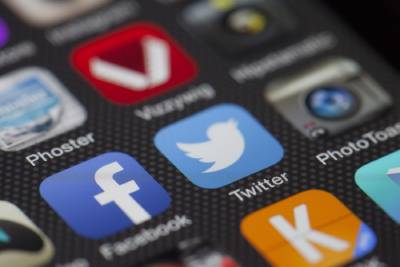
The app industry is worth billions of dollars. Major tech companies such as Facebook partially owe their success to this. Apps are just another way our lives have changed for the better due to innovation.
Made Apple one of the most valuable companies
Prior to the launch of the iPhone, Apple’s sales in 2006 hit close to $20 billion all thanks to the iPod and Mac. Ten years later, and you’ll see how the revenue has increased tenfold. If you break down the sales, most of it is due to the success of the iPhone. See the chart below.
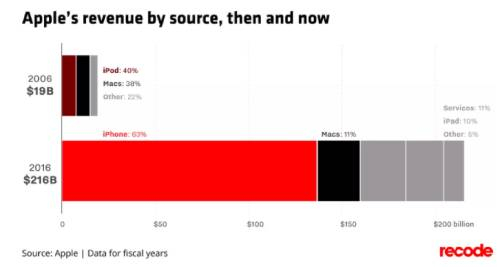
In 2016, after 9 years circulating in the market, Apple’s revenues have reached a whopping $216 billion. 63% of this is attributed to the iPhone.
Opened doors for the Android ecosystem
The existence of the iPhone has led to many good things. Apart from apps, the Android ecosystem has also been on the rise. Companies that used to dominate such as Nokia and Blackberry are barely heard of these days. You have other emerging giants such as Samsung who are benefitting from the courage of Jobs.
With iPhone’s prices much higher than the rest, the market share is being stolen by cheaper competition.
Other Innovations
The iPhone was and still is a mega-hit. It is by far Jobs’ most successful innovation to date. Years after his passing, the iPhone legacy still lives on. As of 2020, there have been 11 versions of the smartphone with a new series being launched almost every year. But besides this revolutionary smartphone, this innovative genius was also responsible for other amazing products.
iPod
Launched in 2001, consumers shifted their attention from MP3 players, Discmans, and Walkmans to the iPod. It is widely recognized as the first user-friendly portable music device. Synced with the Apple iTunes store, users were able to purchase and load hundreds of songs in a single tiny device.
iPad
After the massive success of the iPhone, came the iPad. Its inspiration came from the smartphone and Jobs wanted to create the first touchscreen tablet without a keyboard. A cross between laptops and the iPhone, this innovative product also spurred the development of a new industry. Competitors followed and consumers benefitted from fierce competition.
MacBook Air

When the first Macbook Air was launched, consumers were shocked to see that the CD-ROM had been discarded. But this again shows how forward-thinking Steve Jobs was. He was a visionary that could see things changing before anyone else could. A few years down the road and we’ve all stopped using CDs. Launched in January 2008, the Air was so thin and light. Not only beautiful and sleek in terms of design, but it was powerful enough to do most of your work. The best part was being able to carry your laptop around in your bag like a feather.
Pixar
Many of you might not know this, but Jobs made a very wise investment in 1986. He bought over Lucasfilms’ Computer Graphic Division for $5 million and later renamed it to Pixar. It wasn’t until the success of Toy Story in 1995 that this animations company made a name for itself. And in 2006 after creating a new animation industry in Hollywood, Jobs sold Pixar to Disney for a whopping $7.4 billion.
With all his visionary inventions and accomplishments, it is no doubt that he was miles ahead of everyone. When the iPhone launched and many people thought he was crazy for removing the keyboard, Jobs was fearless. He continued to chase after the things he believed in.
The successful college dropout had this amazing ability to enter existing industries and take control, quickly evolving into the market leader. His ideas and motivation to change the world revolutionized the way we do things, often creating a new industry on its own.
Bonus: Interesting facts
He was a Zen Buddhist
Jobs traveled to India in 1974 in search of spiritual enlightenment. He was known to practice meditation often, didn’t eat meat, and loved to walk around barefoot.
He ripped off his partner Steve Wozniak
During his time in Atari, Jobs and Wozniak built a circuit board for the video game Breakout. Atari had asked the pair to use fewer chips in the device and beyond their imagination, they succeeded in doing so. After completing the project, Atari paid Jobs $5000, but he told Wozniak that he only received $700. The two split the profits and Wozniak got his share of $350. It wasn’t until years later that his partner found out he was ripped off so badly.
He was fired from Apple
Jobs recruited Pepsi executive John Sculley to be the CEO of Apple. After Sculley convinced the board that Jobs was too young, he was fired from Apple in 1985.
He made Google change the yellow shade in the letter “o”
With his incredible attention to detail, Jobs called Vic Gundotra, the former VP of Google. He explained to him that the second “o” had the wrong shade of yellow and that he intended to fix it.
He experimented with psychedelics
Jobs’ drug of choice was LSD and he claimed that it helped him to think differently. His trips were profound experiences that helped with his creativity and innovation.
Elon Musk
Among the number of companies Elon Musk runs, Tesla is the one you probably hear about almost every day. But you might not have known that the world’s most valuable car company has a $0 marketing budget.
As the CEO and product architect of Tesla, Musk is known to make headlines around the world. He knows how to wield the media to shine the spotlight directly on himself and his company. And he does this without paying a single cent. All the funds are allocated to product development, to ensure that the world receives products of exceptional quality.

With other automotive giants spending so much on advertising, it is very intriguing that Tesla has chosen to go the other way. First and foremost, they’ve created a product that matters to people. The cars are so advanced and environmentally friendly, car experts and regular drivers absolutely love them.
Building an amazing product is the first and most difficult step. But if you’re lucky enough to figure this out, the next part is to communicate the product’s value to the market. In this time and age, you need to be able to tell stories that resonate with people.
This is exactly what Musk has mastered. Over the years, he’s developed cool products and has been associated with some very interesting projects. Although he has a slightly awkward presence about him, he does as many interviews as he can to get his brands and products out there. He’s aware of newsworthy factors and potentially viral stories. Clearly, this man knows how to put on a show.
Tesla Motors has no advertising, no ad agency, no CMO, no dealer network. And that’s no problem. – AdvertisingAge
Besides interviews, there are also other acts that have helped to boost Tesla’s image. Here are some examples of how Musk has received so much attention without taking out his wallet:
Bold statements
Saying something absurd is something that Musk does quite often. People might think he’s crazy, but he does know how to make magnetic headlines. Here are some of the things he’s said:
Nuking Mars is the quickest way to make it livable
Vehicles will drive themselves in two years
Apple only hires Tesla’s worst engineers
Cameos
The South African tech mogul has had a number of appearances in Hollywood movies. Let’s take a look at his top five cameos:
-
Iron Man 2
-
The Big Bang Theory
-
Young Sheldon
-
Rick and Morty
-
Why Him
Giving away patents for free
In June 2014, the tech founder announced that he would be supporting the open-source movement. During the early days of his career, he believed in creating and obtaining patents. However, he soon realized that patents merely obstruct advancements. If the goal is to create and accelerate technology to make a difference in the world, then getting patented is no help at all.

In Tesla’s Palo Alto headquarters, you will find that this wall of patents has been removed.
Fulfilling a dying man’s wish
Musk was involved with another act of generosity in 2016. There was a long line of people waiting to receive their Tesla Model S. In December 2013 at the age of 29, Ryan Wagner was diagnosed with colon cancer. With the disease spreading to his lymph nodes and lungs, doctors stated that he only had a few years left to live.
Knowing that he didn’t have much time left, Wagner started crossing off items on his bucket list. Among his many wishes was owning a Tesla. He ordered the Model S and when the dealership got to know about his story, they bumped him up the production queue. Wagner sadly passed away in January 2018.
Using Youtube
As one of its marketing strategies, Tesla has its very own YouTube channel. As of August 2020, the channel has 1.39 million subscribers. It uses the video distribution platform to showcase its latest models and technology so viewers can enjoy the Tesla experience.
Here is one of its latest videos giving viewers a peek into the latest developments to help with the COVID crisis.
Emphasis on safety
One of Tesla’s biggest principles is its focus on safety and using technology to improve safety. Tesla mobiles are considered to be the safest cars in the world. On the Tesla website, you will find this statement regarding its safety standards:
We believe the unique combination of passive safety, active safety, and automated driver assistance is crucial for keeping not just Tesla drivers and passengers safe, but all drivers on the road. It’s this notion that grounds every decision we make – from the design of our cars, to the software we introduce, to the features we offer every Tesla owner.
It’s mandatory for all cars to get tested by the U.S. government’s New Car Assessment Program. Model S, Model X, and Model 3 have achieved extremely high safety ratings. Tesla’s models have a very low center of gravity, which attributes to the rigid and powerful structure. Due to this, if ever a Tesla car is involved in an accident, the battery has very low chances of getting damaged. And if in the slightest chance there’s a fire, the advanced technology has a safety system in place. It isolates the fire to other parts of the battery that are less dangerous while pushing heat away from the vehicle at the same time.
It would be a dream to have a car that can prevent all types of accidents. Although it is pure imagination, Tesla does come very close to it.
Working on massive and impactful developments
Tesla and Musk are on a mission to creating a better world. Their main focus is on the world’s transition into sustainable energy. With the majority of cars running on gasoline, Musk would like to see more electric vehicles and energy products on the road. To achieve this, he’s striving to manufacture affordable electric cars.
To be able to produce and deliver 500,000 cars per year, every single lithium-ion battery that exists on this planet is necessary. With that in mind, the Gigafactory was built in order to supply enough batteries to support Tesla’s car production. This massive structure of a factory produces the Model 3 electric motors and battery packs as well as other energy storage products.

Located outside Sparks, Nevada, the Gigafactory covers an area of approximately 1.9 million square feet. With its several floors, there’s an operational space of close to 5.3 million square feet. Opening its doors in June 2014, the name truly represents the size and mission it is trying to accomplish.
Although the entire project is still years from completion, Tesla has already begun manufacturing inside. Once complete, the Gigafactory will be the biggest building in the world and powered only by renewable energy sources. With the aim to be a net-zero energy factory, the factory will solar-powered.
Free ads & publicity from Project Loveday
According to Tesla’s policy, the company does not do traditional advertising. It does things a little differently and chooses to earn respect through PR acts. Loved by so many, the innovative car manufacturer has even received free ads made by superfans.
And then one day, a 10-year old girl by the name of Bria Loveday sent a letter to Tesla suggesting that they hold a video contest. The automotive giant thought it was such an awesome idea and Project Loveday was launched in 2017.
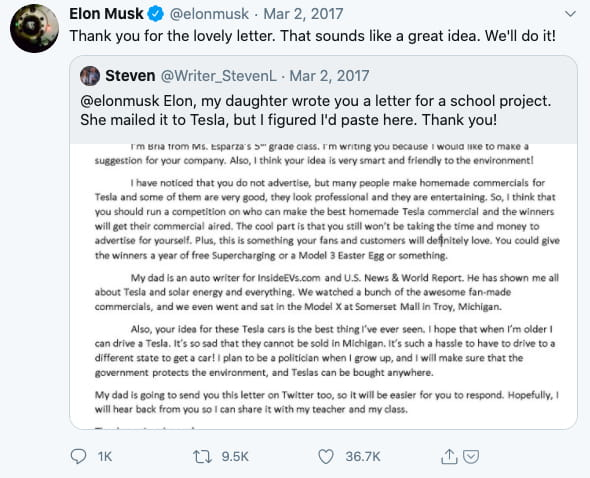
For a few months, Tesla collected videos from all around the globe. All submissions had to be related to Tesla and kept to 90 seconds or less. Videos were judged based on these four criteria: originality, creativity, relevance to Tesla, and entertainment value.
The winner didn’t get a Tesla. The Grand Prize was an invitation and public introduction at a future Tesla product launch. Here was the winning video by famous YouTuber Marques Brownlee:
Extremely active on Twitter
It’s no secret that the billionaire CEO loves his tweets. His presence on the social media account dates back to 2011. With 37.6 million followers, he’s able to tweet to a huge audience and have his voice heard.
With every year that passes by, his twitter feed seems to be expanding. If you check out his profile, he doesn’t have a tweeting routine. He’ll randomly tweet at any time of the day and late into the night.
The effectiveness of marketing through Twitter has shown that it’s about time other CEOs jump on board. For the automotive industry, stats indicate that over 95% of people explore digital channels when they research on cars. Specifically, social media is used to check out reviews, listen to what others have to say and to follow influencers. It’s a virtual gallery for brands and products to showcase their expertise.
Among all the major tech CEOS, Musk ranks second as the profile with the most tweets. Only Salesforce CEO Marc Benioff tweets more than him. Not only are most of his activity tweets, but he also replies to anyone – literally anyone.
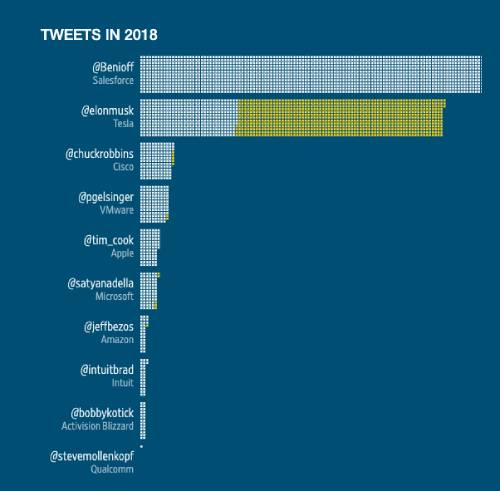
This is the marketing genius interacting with ordinary citizens. The blocks in yellow are his replies. More than half of his activity on Twitter is a reply. He’ll answer anyone regardless of the number of followers you have. His popularity on Twitter is also attributed to the fact that he uses a very casual tone. Unlike other very serious CEOs.
Here is a list of things he uses his social media account for:
- To make jokes
- To share about his personal life
- To give insight into his various businesses
- To ask the market what they want
- For customer service
- To spar with critics
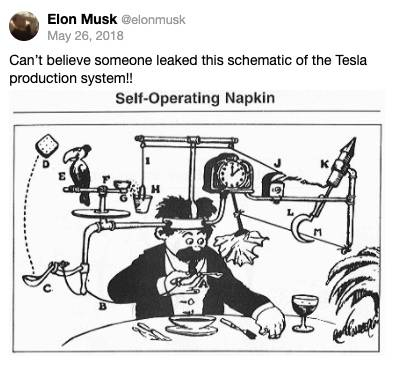


It’s a combination of his humor, casual tone, and genuine self that makes him very likable on social media. At times, he might tweet about the wrong thing, but he has shown how powerful a marketing tool Twitter can be. If you run a business, you should be jumping on the wagon.
He doesn’t believe in market research
Apart from his zero paid advertising policy, the South African billionaire also knows how to allocate budgets wisely. Ignoring this aspect of the company, he has claimed that he does “zero market research whatsoever”.
“A lot of times people try to make products they think others would love but they don’t love themselves.” – Musk at a conference
The Tesla CEO has absolute faith in his product. He believes that if you love your product, others will too. And they will be interested in buying it. In other words, you need to focus on developing an amazing product and it will market itself.
On the contrary, many other large corporations still place their bets on market research. It’s not the wrong path either as it has also proven to be successful over the past decades. If you’re thinking about whether you should be conducting this type of research, here are some situations for when market research might not be necessary:
1. When your product is beyond the market’s imagination
You might be developing a product that the world has never seen before. Though you’re convinced that it will improve their lives, they might not be ready to accept it. A good example is when Ford started producing cars. It is rumored that Henry Ford once said “If I asked the people what they wanted, they’d have said faster horses”.
This was during a time when people used horses to get around. Asking them for their opinion on such a new concept would have been unfathomable.
2. When time is ticking
When time is of the essence, you can’t waste time on consumer research. This type of study could take years. There are just too many phases and tests to run. While you’re spending time conducting research, a competitor could overtake you as well.
3. When you trust the experts in your team
You’ve been working with your team of experts that they have become your trusted advisors. If you have faith in them, their opinion is often better than the market’s thoughts. Let your team go wild with their innovation and develop new ideas.
4. When failing doesn’t mean bankruptcy
It saves a lot of time, effort, and money to just develop a product and put it out there. Go with the flow and see what happens. If the market responds positively, then it’s a successful product that can go into the next phase of mass production. On the other hand, if it is met with negative responses, it would be considered a failure. But a cheap failure that you can afford and learn from. Then, move on to the next idea.
Jeff Bezos
Jeff Bezos is currently the richest person on the planet. Amassing his wealth from online retail giant Amazon, the CEO and founder started his company in July 1994 in his garage. From humble beginnings to becoming the first person with a fortune exceeding $100 billion, he has always believed that the growth of the Internet would overtake the brick and mortar industry.
The year 2020 has been an amazing one for the world’s wealthiest people. Apart from Bezos, Elon Musk and Mark Zuckerberg have also added billions to their bank. Today, Bezos is on the verge of being the first man to reach the $200 billion mark. He might just be the world’s first trillionaire if things continue to go in his favor.
A highly intelligent individual, the Princeton graduate has grown Amazon into one of the most powerful companies. This brilliant mind does things his own way, he refuses to have a typical meeting structure with PowerPoint presentations. Many years ago, he replaced these presentations with reading and silence. Each meeting begins with attendees reading the memo for the first 30 minutes of the session.
This is just an example of how he leads. But besides his management style, his success is mainly attributed to his business strategies. He might not have the charisma of Elon Musk, but his entrepreneurial brains are worth picking. If you’re interested in running your own business, there’s so much you can learn from this guy.
Here are his top 10 business strategies:
Dream BIG
When you’re setting your goals, think big and picture how you see yourself in the next few years. Having big dreams will give you the energy and excitement to keep chasing. Even if you don’t end up achieving that goal, you’ll be occupied with activities every day that will make you an improved person.
When Bezos first started Amazon back in 1994, he warned investors that there was a 70% chance of failure. But he also told them that by 2000, sales would reach $100 million. In fact, the sales outperformed his projections and reached $1 billion.
His early success was due to his courage to pursue the impossible. With Kindle, Bezos imagined a world where readers would be able to buy, download, and enjoy a book from anywhere. This was before cell phone data hit it big.
When he told the designers his idea, they responded with negativity. He didn’t care that the designers were hesitant. He told them to just get it done and eventually they did.
Hiring is Key
The employees are the backbone of the company. They’re what keeps the engines running. Depending on your style of leadership and principles, always try to hire the best out there. You don’t want to end up with someone that doesn’t want to work towards your goals and vision.

As for Bezos, he’s always had high standards for new recruits. He believes that you have to continue raising the bar. Contrary to popular practices, he does not support work-life balance. Once again, hiring also varies on the way you run your company.
It might seem outrageous, but he firmly sticks to his judgment. He’s only on the lookout for people who are gladly willing to work 60 hour weeks. He finds people that also share similar expectations.
Dare to experiment
This is a great quote by Bezos:
“If you double the number of experiments you do per year you’re going to double your inventiveness.”
Through experimentation, new innovations are born. It’s how companies stay competitive in the market. You have to keep finding ways to improve your product or introduce a new one into the market.
Here’s how Amazon ran a few experiments:
- The effectiveness of TV advertising: Bezos wanted to know how this strategy would impact their sales. For 16 months, they advertised in two markets – Portland and Minneapolis. After an expensive campaign, he had the answer. Although Amazon sales slightly edged higher, he decided that it simply wasn’t worth it. In the end, this experiment led to Amazon having a more focused advertising strategy.
- Free shipping for orders above $25: Amazon has a program called Super Saver Shipping. It offers free shipping only for orders over $25. This makes the customers extremely happy, but when you do the math, it’s simply not feasible. From this experiment, Bezos learned that he gained customer loyalty and more orders in the long run.
If you believe in something, don’t be afraid to test it out. If it doesn’t work out, quickly accept and recognize the failure and move on.
You should invent, not the customer
As an entrepreneur, you should always be passionate about coming up with something new. It’s your responsibility and not the customers. If you ask your customers for their opinion, they will just tell you what they don’t like. They won’t exactly tell you how to do something in a different way.

No matter what field you’re in, you need to be brainstorming and experimenting. According to Bezos, inventing is one of the most important factors for him and his team at Amazon. Ever since his childhood days, he’s always loved creating and when he’s hiring, he tends to choose those that love it too.
Regret minimization framework
Living life as an entrepreneur or startup founder poses its many challenges. You’re going to be faced with choices and life-changing decisions. There isn’t a single method that works for everyone as we are all unique individuals. However, if you’re stuck and contemplating certain decisions, you could try out this mental framework.
Here’s the framework coined by Bezos when he chose to start his own company. At the time, he wasn’t young and it was a very risky move considering he had a family to feed. But it all came down to what he would regret more on his death bed.
I knew that when I was 80 I was not going to regret having tried this. I was not going to regret trying to participate in this thing called the Internet that I thought was going to be a really big deal. I knew that if I failed I wouldn’t regret that, but I knew the one thing I might regret is not ever having tried.
The eCommerce founder was faced with the decision to play it safe with his stable job or take his chances with his business idea. With this framework, he easily decided to go for it. He looked into his future as an 80-year-old man and thought about minimizing whatever regrets he might have. He knew that at 80, he wouldn’t regret going down this path.
Put the magnifying glass on your customers
This is Bezos during an interview with Charlie Rose:
“We’re not competitor obsessed, we’re customer obsessed. We start with the customer and we work backwards.”
Many companies do the opposite. They brainstorm the idea first, then start developing the product, and finally test it in the market.
When you can identify the customer’s needs and problems, you’ll be able to build what is best for them. In turn, that will be what’s best for the company as well.
Here are some examples of how Amazon focuses on its customers:
- Warn customers about having duplicate orders: there’s a feature that warns customers when they visit the same page of a product they had already purchased.
- Encourage customers to leave a review: this feature provides genuine and honest value. When potential customers want to conduct research on a product, they check reviews before deciding to make a purchase. By being transparent with them, you’re actually gaining their trust and loyalty.
- Allow competitors to advertise on your website: it’s best to give customers more choices, but still stay within the Amazon marketplace.
The limitless potential of eCommerce
The eCommerce industry has been booming with the help of the Internet. Scalability, reach, and convenience has turned many shoppers into online shoppers. You can find just about anything on the Internet these days.
As Bezos was building his empire, he noticed the many strengths of eCommerce and took advantage of them. He understood that you could get deeper insights into your customers as compared to offline. For example, he created an algorithm that recommended products based on your purchase history. This resulted in an increase in sales. Another example was the affiliate program he set up. This program allowed anyone to join and recommend products. Today, it has grown into a billion-dollar affiliate program.
Be frugal and thrifty
Especially when you’re just starting out, you have to be smart with money. You can’t be forking out cash on things that aren’t important. Every cent counts and must be used properly. And even when you’ve earned a good amount, always try to spend less than you make.
Although you see many wealthy people splurging and living the high life, you’ll see Bezos trying to cut costs anywhere he can. It is rumored that he adopted his frugality from a successful businessman named Sam Walton. He learned it from Walton’s book ‘Made in America’.
I think frugality drives innovation, just like other constraints do. One of the only ways to get out of a tight box is to invent your way out. – Jeff Bezos
Here are some examples of Bezos being thrifty:
- His employees are not allowed to fly business class
- During business trips, his employees are put up in the Holiday Inn (2 people per room)
- He created an employee loyalty program to save money
Lower margins, higher turnover
If you’re new to the business world and haven’t heard the term “margin”, it is the difference in price between the product cost and selling price. Depending on the way you want to model your business, you could either go for high or low margins. Many businesses prefer high margins because it means having to do less work.
For the Amazon tycoon, he sees lower margins as the perfect opportunity to beat the competition. When you have lower margins, your customers will be over the moon. Customers love paying less for good quality products. And you’ll have new customers as they leave your competitors.

Lower margins can result in having a higher turnover. A huge sales volume with small profits accumulates into a lot of money.
Be on the frontlines with your employees
There are many leadership styles out there. Frontline leaders are doers. They’re able to do what their employees do. It is inspiring for many to see that their leader is willing to actively participate in daily work activities.
As a leader, your role is to create an environment that reflects your vision, mission, and values of the organization. You are setting an example that others will follow.
In terms of leadership, Bezos is willing to do any type of work. He would even do the handy work in the manufacturing department if there was a need for it. When Amazon was at its busiest, you would see him around doing work and wearing many hats.

Today, Amazon isn’t just the online bookseller it set out to be. With its many business strategies and strict practices, it has dethroned Walmart as the biggest U.S retailer. Besides the retail industry, it is poised to disrupt others such as consumer electronics, artificial intelligence, cloud computing, and entertainment media.
In the next ten years, you’ll continue to see Bezos owning the internet as well as jumping into new ventures. With Project Kuiper, it will be years before it takes off, but he’s already begun to compete with Elon Musk’s SpaceX. Although Musk was the first to work towards offering satellite-based broadband internet, Bezos has joined the race.
Having leased over 200,000 square feet in Redmond, Washington, Project Kuiper is set to roll out Bezos’ broadband internet plans. The project has been described as a constellation of 3,236 satellites deployed in low Earth orbit for high-speed broadband. When this gets launched, the world will witness total internet domination by Bezos.
Mark Zuckerberg
“Understanding people is not a waste of time.”
—Mark Zuckerberg
Your team is so crucial to the success of the company. As a leader, you’re responsible for steering everyone in the right direction. Duty calls to create a thriving work environment and to encourage all employees to produce the best work possible.
This year, Facebook celebrates its sixteenth birthday. With over 2.4 billion users, it is the largest social media platform that can be found on almost everyone’s smartphone. As it aims to connect the global population, the app has become a huge part of modern society.
Continuing the trend of successful college dropouts is Mark Zuckerberg. Dropping out of Harvard in his sophomore year to focus on Facebook, Zuckerberg co-founded the service along with some college mates. Today, he serves as not only the co-founder, but as its chairman, chief executive officer, and controlling shareholder.
Finding success at a very young age, the Facebook CEO became a billionaire at the age of 23 following the social network’s IPO in 2008. This move made him one of the youngest self-made billionaires of all time.
Regardless of your company size, there’s so much you can learn from this young billionaire. Let’s dive deeper into how he leads his employees and the management strategies that made him the social media juggernaut he is today.
The 5 P’s
If you’ve ever read the book Think like Zuck: The Five Business Secrets of Facebook’s Improbably Brilliant CEO Mark Zuckerberg, you would have come across the 5 P’s. Over the years, the social media magnate built his empire with a mentality that drives great leaders to build amazing businesses.
The 5 P’s described in the book are:
PASSION — Keep your energy and commitment fully charged at all times by pursuing something you believe in.
Zuckerberg once explained, “The question I ask myself like almost every day is ‘Am I doing the most important thing I could be doing?’”
Ever since he was a young boy, he’s always been passionate about designing programs where people got to interact with each other. This is what drove him to start Facebook.
If the work you do is something you believe in, it won’t feel like work at all.
PURPOSE — Don’t just create a great product, drive a meaningful movement.
Purpose goes beyond the product. In terms of Facebook, it’s not just a great product. Zuckerberg has a long-term vision that he’s driven about. He won’t stop until he’s fulfilled his purpose – which is to connect the global population through his social networking platform.
PEOPLE — Build powerful teams that can execute your vision.
The third P involves all the humans that will bring you closer to your vision. You’ve got to not only hire amazing people, but also those that align with the company’s culture and vision. You can do this by sifting through a ton of resumes and also by having a strict screening process. Make sure that they are qualified individuals and that they share the same values to be a team player.
PRODUCT — Create a product that is innovative, that breaks all the rules, that changes everything.
Having majored in Computer Science and Psychology, Zuckerberg has always had a deep understanding of the way humans technology. He prioritizes the problems of people first. In doing so, he’s been able to develop a product that fulfills the needs of its users.
More than 2 billion people around the globe are able to stay connected with each other. Moreover, they get to share updates and media with their own networks. There are also many other features that Zuckerberg has developed, putting Facebook far in front of other platforms.
Here are some of the innovative features he’s added to the social networking platform that has taken it further than what it set out to be:
- Facebook platform for developers
- Social Ads
- Facebook Messenger
- Facebook Graph Search
- Facebook Business Manager
- Facebook Marketplace
PARTNERSHIPS — Build powerful partnerships with people who fuel imagination and energize execution.
The saying that you can’t do things alone is often true. To be able to achieve great things, you’ll need a sidekick. Look at Steve Jobs and Steve Wozniak for example. Having a partner that shares the same vision as you gives you more motivation and purpose.
When it comes to Mark Zuckerberg, he’s got a great vision and tremendous creativity. But alongside Sheryl Sandberg, the Chief Operating Officer, things at Facebook have skyrocketed. A lot of its business success has been owed to Sandberg’s efforts. Although they have different strengths and weaknesses, they just seem to complement each other and it works.
As you’re moving along, always think about the right partnerships. It could be a business partner, supplier, distributor, producer, developer, or something else.
Office culture
Depending on your beliefs and interests, you’ll have to create an office culture suitable to you and your team. At Facebook, the young billionaire has a relaxed and open corporate culture that heavily emphasizes on diversity and equality. There are no physical constraints – no cubicles, no walls, just office furniture. Everything feels really open.
What’s really interesting is that the top guys in the company also don’t have their own offices. Zuckerberg and Sandberg occupy the same workspaces as the other employees. This emphasizes even more on his principles of openness and equality. Outside of that, Mark also holds 1 hour Q&A sessions every Friday. It gives employees the chance to voice their opinion and feedback on work-related matters. Giving them the freedom to be open encourages better teamwork and friendlier communication.

Another jaw-dropping factor is the dress code. In a superficial world where what you wear says a lot about you, people who work in high-level positions are often pictured wearing suits. Not at Facebook. Employees are allowed to wear T-shirts, jeans, and flip-flops to work! Besides being comfortable in whatever you want to wear, you’ll see another reason as you continue reading this.
Spend less time in the office compared to other CEOs
The social media tycoon doesn’t spend hours and hours in the office. According to some studies, working really long hours can affect your productivity levels. Instead, Zuckerberg spends a lot of time pondering about connecting the global population and bringing better products to the community.
Razor-sharp focus
“Once you know what change you want to make in the world, all of the tactics and strategies for how you do that just fit into that change,” said Zuckerberg.
If you are truly passionate about something, all those ideas will transform into focus. To start with, you’ll need to find that fire that’s going to drive you to make changes.
Don’t waste time on small decisions
Connected to one of his office culture principles, you’ve probably seen the grey shirt often worn by Facebook’s CEO. In fact, he wears the same type of shirt on a daily basis. He believes that dressing simply is not only comfortable, but it eliminates having to make small decisions.

Being so fixated on his vision, he wants to be using his energy on important decisions. Having to make fewer decisions, gives you more time to concentrate on priorities.
Be proactive, not reactive
With the way he manages his time, he tries to maximize his productivity and effectiveness. Rather than waiting for something to happen, he’d rather be proactive than reactive. When you’re reactive, you’re just waiting for something to happen. And when it does happen, it might waste your time reacting to it.
Don’t wait for something to happen. Be proactive and set out to accomplish goals each day.
Encourage your employees to correct you
A lot of CEOs might have a huge ego that intimidates their employees. But this is not the case with Zuckerberg. With the open office culture, he is not embarrassed about making mistakes and being corrected. He’d much rather have employees stand up and voice out.
That’s the whole point of being a team. If anyone in the team, including the leader, makes a mistake, he or she should be corrected.
Recognize and accept your mistake, then quickly move on
Many of the world’s most successful innovators say this as well. You’ve got to be able to fail and keep going. Don’t dwell on your mistakes. As humans, we’re bound to make mistakes. No one is perfect.
Have the courage to make mistakes because you will learn a lot from it. A lot of people play it really carefully as they focus on avoiding mistakes. Living life like this won’t get you out of your comfort zone. Playing it safe will give you fewer worries, but it will also limit your potential.
Taking calculated risks is okay
Zuckerberg has been risking it his whole life. Not many people have the courage to drop out of a great school like Harvard. But he did in his sophomore year. He saw the opportunity in Facebook and prioritized it. 
If you look into the other moves he made over the past few years, you’ll notice that he was not afraid of risk at all. Betting heavily on the future of going mobile, he got his company publicly listed in 2012. Not only that, but he also bought Instagram for $1 billion and WhatsApp for $19 billion. He took really big calculated risks.
Know when to say NO
As a leader, knowing when to say no is also crucial. For example, if you’re focused on something, in particular, try not to take on too many projects if you don’t have the infrastructure or resources to do so.
In Zuckerberg’s case, he was keen about venturing out of Facebook. But he learned his lesson. The young CEO developed a software called Wirehog. It was a service that allowed users to share media with each other. He envisioned this service to be integrated into Facebook.
Although he was really excited about this project, others opposed it. Sean Parker, who had experience working in Napster, advised him against it. However, Mark didn’t listen to anyone. He continued developing Wirehog and it launched in November 2004. After a few months, it wasn’t working out and the young leader had to make a tough decision. In the end, he shut down Wirehog and re-focused on building Facebook.
Acknowledge your weaknesses
Everyone has strengths and weaknesses. It’s only normal. If you are able to identify and acknowledge your setbacks, you’ll be able to improve. As a very young CEO, Mark said this to his team:
“It may not make you comfortable to hear me saying this, but I’m sort of learning on the job here.” – Zuckerberg on his role as a CEO during the early days
Honesty and transparency are values he embraces. What is really admirable is that he makes the effort to become a better leader as he learns from his experience. When he was only twenty-two and there were rumors going around that Facebook would get acquired, he started going for sessions with an executive coach. This taught him how to be a stronger leader during uncertain times.
As employees started to feel restless not knowing what the future held, he also organized more meetings with everyone as well as with the executive team. From this, he learned that candor is certainly one of the most essential leadership qualities.
What the Future Holds for the Facebook CEO
As we look back to the birth of Facebook, it was a social networking platform available for only Harvard students. After 16 years in existence, it has become a global success with one-third of the world’s population. With the acquisition of WhatsApp and Instagram, Zuckerberg has become a household name in the communications industry.
“I believe the future of communication will increasingly shift to private, encrypted services where people can be confident what they say to each other stays secure and their messages and content won’t stick around forever.” – Mark’s opinion on the future
The social networking mastermind aims to get the whole world on one communication platform. As he continues working towards this, there will also be extra emphasis on privacy. Take a look at how quickly Facebook jumped into “Stories”. Although Snapchat was the first to introduce this feature, Instagram and Facebook quickly adopted it as well. With “stories”, content only lasts for 24 hours. People don’t always want to have content saved on their profiles.

When users know that content will automatically expire, they feel more comfortable to share. Not only that, but you have the choice to save them in your archives if you want to. This provides a glimpse into the future that perhaps content expiration will be extended to all areas of communication, including private messaging.
Community

Congratulations on reaching the end!
Check out our podcast Impact Talks, where you can listen to high-profile experts from various backgrounds!
Join our Facebook Group Community with over 4,700 entrepreneurs, innovators, and creators by Startup Funding Event, where you get access to free live training, daily Q&As, design templates to get your business started, and support from the SFE team. Join here!

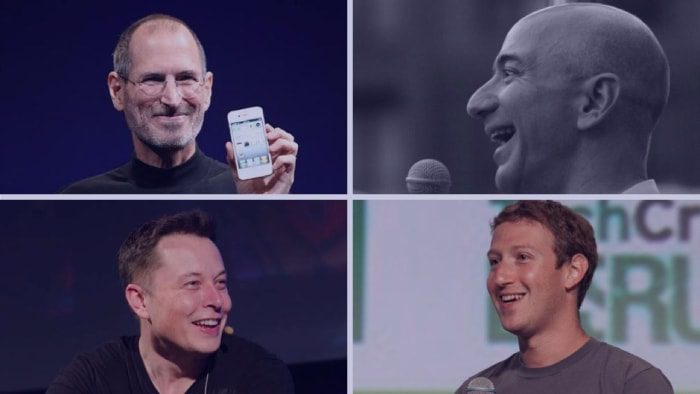


Leave a Reply
Want to join the discussion?Feel free to contribute!